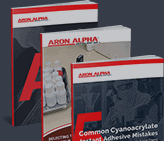How to Remove Super Glue From Skin, Plastic, Glass, Fabric, and More
Cyanoacrylate glue, also commonly known as Krazy Glue or super glue, is an instant adhesive that creates exceptionally strong polymer bonds between a variety of materials. Unlike other adhesives, cyanoacrylate (CA) glue does not require additional treatments to cure and harden to the surface of a material. Exposure to moisture or humidity in the air is sufficient to activate the bond between the active ingredient, ethyl cyanoacrylate, and the material. Anionic polymerization triggered by exposure to water molecules allows CA glue to create polymer chains that can bond to a range of materials, from wood and metal to ceramic, leather, and plastic.
While CA glue is chosen for its excellent bonding, this same property can be problematic when the glue adheres to an unwanted surface. Fortunately, there are a variety of methods to remove super glue from your skin, plastic, glass, fabric, and other surfaces.
How to Remove Super Glue From Skin & Hair
When applying cyanoacrylates, it’s common to accidentally get some of them onto hands and hair. Since the skin produces moisture naturally, it is easy for super glue to bond quickly upon contact with your skin. To prevent CA glue from adhering to your fingers and hands, wear appropriate gloves and protective gear when applying the adhesive. In the case of an accident, you can easily remove super glue from skin on your hands and fingers using acetone or nail polish remover. For hair, lips, and other sensitive areas, peanut butter, margarine, and vegetable oil are substances that are also able to break the bond.
How to Remove Super Glue From Plastic
Cyanoacrylate adhesives can bond particularly well with plastic materials, and removing the glue can cause damage to the surface if not careful. To avoid damage to plastic materials, soak the area in a mixture of ammonia-free detergent and water. This can soften the bonds between the glue and the material’s surface enough for you to remove the glue without damaging the finish. If mild detergent doesn’t work, you can use nitromethane, a less harsh chemical solvent than acetone that will cause less damage than acetone, especially in the event that the surface is coated with paint or varnish.
How to Remove Super Glue From Glass
Super glue adheres easily to glass, which can be particularly troubling when that glass is your eyeglasses, a window, or another delicate surface. For scratch-resistant glass surfaces, you can use solvents to loosen the glue and scrape the loosened glue off with a razor. However, more care must be taken with eyeglasses, which can be damaged more easily. In that case, use hot water, acetone, rubbing alcohol, and toothpaste, and other gentle solvents to gently remove the glue.
How to Remove Super Glue From Fabric
Getting superglue on your clothes can be especially frustrating, but it is typically easy to remove once it has hardened, depending on the fabric. Try scraping the glue off with a spoon or butter knife. If there is still hardened residue, spot check a section of the fabric to see if it is affected by acetone. If your spot check is successful, simply apply a small amount of acetone to the glue using a cotton ball or swab. This should loosen the glue sufficiently to allow you to remove it. Finally, you can apply some detergent or stain remover and wash the article of clothing to remove the remaining glue. If you are trying to remove the glue from a delicate fabric, it may be best to take it to the dry cleaner to avoid damaging it more.
How to Remove Super Glue From Metal
Super glue bonds quickly and easily to metal, but it can easily be removed from metal surfaces using a solvent such as acetone, a scraping tool, and a hammer. Simply apply a small amount of solvent to break the adhesive bond, and then use the scraping tool to remove the softened adhesive. For large drops, you can use a hammer to loosen a dried cyanoacrylate spill by lightly tapping it.
How to Remove Super Glue From Wood
Wood is extremely porous, which makes it easier for super glue to adhere, but also makes it harder to remove. Unlike metal, wood can become stained or discolored when exposed to solvents such as acetone. You can reduce the strength of your solvent by mixing it with water, but be sure to perform a spot test out of sight before applying the solvent to your wood surface. Use a cotton ball or swab to apply a small amount of solvent, and then use a scraping tool to lift the glue from the surface once it has begun to soften. Oils can also help to remove glue spilled on untreated wood surfaces.
Choose Super Glue at Aron Alpha
Aron Alpha offers an extensive selection of cyanoacrylate adhesives for a variety of materials and industrial applications. With more than 50 years of experience, we specialize in the development innovative adhesive solutions, including custom formulations.
Our ISO 9001:2015 and IS 14001:2015 certified facility is designed to provide the highest quality products. To learn more about Aron Alpha’s portfolio of cyanoacrylate solutions, contact our experts today or fill out a request for information.




